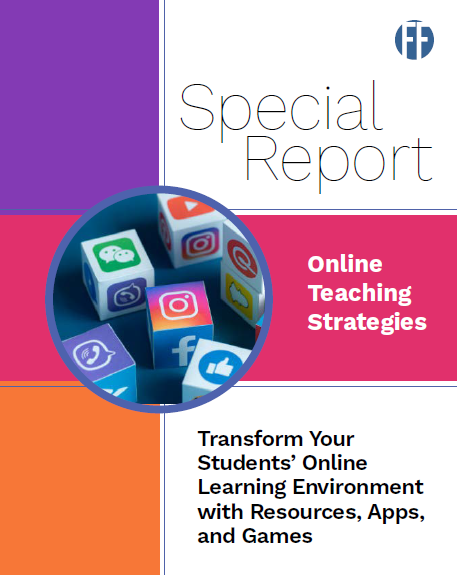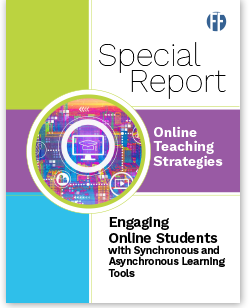Online teaching. Online learning. Online engagement. You’ve heard it all when it comes to online pedagogy. But have you come across a resource that contains all the online pedagogy techniques and tips you could ever want and imagine about online teaching?
You want to create effective online videos, but you also want to make your online discussion boards more engaging, while at the same time incorporating synchronous and asynchronous activities into your online classes that infuse equity and diversity. Meanwhile, you’re trying to maximize your time and manage your online office hours while reaching out to students struggling with the online realm. And you’re doing all this amidst a pandemic. Sound familiar?
The following articles, reports, resources, seminars, programs, courses, and more will help ease the craft of becoming a brilliant online instructor while providing you with effective online teaching strategies to balance and maximize your time.
Browse our topics below:
- Online discussion boards
- Creating effective online videos
- Incorporating equity and diversity into your online class
- Maximizing your time in online courses
- Strategies for teaching students struggling online
- Asynchronous and synchronous activities for the online classroom
- Pandemic teaching resources

Online discussion boards
“I really enjoyed reading your post. I especially liked the part…”
Does this look familiar to your online discussion posts? If so, have you ever thought about using superheroes, games, or student autonomy to help guide your online discussions? Or maybe you’re not asking the right questions to stimulate engaging online discussion. The following articles and resources offer techniques and strategies to encourage a lively online discussion among your students while offering students a safe space to share their voices.
Free articles
- Enhancing Online Course Discussions through Conference Roles and Blogs
- A Discussion About Online Discussion
- Improving Breakout Room Discussions in Online Teaching by Using Collaborative Documents
- Five Ways to Promote Student Autonomy in Online Discussions
- Organic Online Discussions: Saving Time and Increasing Engagement
- How Superheroes Can Bring Your Online Discussion Board to Life
- How to Make Your Virtual Discussions Engaging, Effective, and Equitable in Eight Steps
Teaching Professor articles (requires paid subscription)
Related products
-

Seven Ways to Facilitate Effective Online Discussions -

What are the Best Questioning Strategies for Enhancing Online Discussions? -

How Do I Create Questions that Stimulate Engaging Conversations in Online Discussion Boards? -

How to Design and Facilitate Online Discussions that Improve Student Learning and Engagement

Creating effective online videos
As many transition to online learning, creating videos may not be in your repertoire. But that’s the wonderful element about teaching—you’re always learning. Maybe you’ve gotten more familiar with creating online videos, but you also may be interested in taking your videos to the next level. Here, you’ll learn how to transform your lectures into online videos while also learning how to create animated videos and trailers that treat your work like a coming attraction. Being an effective and engaging online teacher will be easy with your newfound video-creation skills. Lights. Camera. Action!
Free articles
- Transforming Your Lectures into Online Videos
- Extending the Shelf-Life of Your Instructional Videos: Six Common Pitfalls to Avoid
- 10 Tips for Creating Effective Instructional Videos
Teaching Professor articles (requires paid subscription)
- The Power of the Short: Making the Most of Brief Instructional Videos
- Add Interactions to Your Online Videos
- Video Trailers: Treat Your Work like a Coming Attraction
- Unifying Course Themes with Animated Videos
Related products
-

What are Five Tips for Creating Videos that Promote Knowledge and Expand My Reach? -

What are the Secrets to Making Highly Effective Educational Videos? -

How Can I Make My Video Lectures Effective and Engaging? -

How Can I Repurpose My Content into Videos That Get Viewed (and Shared)? -

Create Influence Beyond Campus: Video Basics for Faculty

Incorporating equity and diversity into your online class
Making sure your students feel included and accepted is always a priority but not necessarily at the forefront of online course design. So, how can faculty and universities not only make diversity, equity, and inclusion a mission on campus and in the classroom but also portray inclusivity throughout all online courses. These articles, free reports, and seminars focus on creating a welcoming and diverse environment in all online courses and while portraying inclusivity through your online teaching. You’ll learn how to infuse equity into all of your online course content, assignments, and syllabus despite being behind a computer screen.
Free articles
- From Inclusion to Equity: Pedagogies that Close Achievement Gaps
- Finding Our Way to Equity*
- How to Build Inclusive Practices in Education
Teaching Professor articles (requires paid subscription)
- Tips for Creating a More Inclusive Syllabus
- Considering Language When Creating Inclusive Learning Environments
Free report
Related products

Maximizing your time in online courses
You’ve got 495,903,237 things to worry about in an online course. Is your video working? Are students tuned in? Are the breakout rooms in full discussion? Does someone have a question in the chat? And how will you structure virtual office hours for your students? Here, we offer tips for utilizing teaching calendars, offering virtual office hours, and honing your online course design skills to help maximize your time and effort. You’ll utilize effective teaching strategies that encourage time-saving tips and align with the rhythm of the online semester.
Free Articles
- Using Breakout Rooms with Less Stress and Better Results
- Taking Your Classes Online in a Flash
- Managing the Chat in Online Teaching: What We Can Learn from Live Streamers
- What Online Faculty Can Do to Avoid Burnout
- Eight Steps for a Smoother Transition to Online Teaching
Teaching Professor Articles (requires paid subscription)
- Time-Saving Tips for Teaching large Online Classes
- Ten Productivity Strategies Online Instructors Can Borrow from Entrepreneurs
- Creating a Course Calendar that Aligns to the Rhythms of the Semester
Free Report
Related Products

Strategies for teaching students who are struggling online
Not all students are equipped to handle online classes, but it doesn’t mean they can’t become equipped to flourish in their online courses. Although teaching student autonomy is no easy feat, there are numerous strategies to encourage your learners to become successful in their online endeavors. Maybe your students need some “Midweek Motivation,” or maybe your students need a reason to feel connected to you and the class. The following are ideas, tips, and strategies for the students who ghost, for those who just need an extra helping hand, or for those who show defiance toward taking classes online. You’ll learn how to assess online learning while motivating your students to succeed in their online classes.
Free Articles
- When the Tide Goes Out: Identifying and Supporting Struggling Students in Online Courses
- Supporting Underprepared Students in the Online Classroom
- Encouragement for Online Learners
- Scaffolding Online Student Success
- Emotions in Online Teaching: A Powerful Tool for Helping Online Students Engage, Persist, and Succeed
Teaching Professor Articles (requires paid subscription)
- Identifying Goals Helps Online Learners Sustain Self-Motivation
- Graphic Organizers: Strategies to Support Students
- Understanding Resistance to Online Learning
Free Report
Related Products
-

How Can I Add Choice to My Course to Give Students Autonomy and Motivate Deep Learning? -

Increasing Student Engagement, Persistence, and Success Online Using Emotion Science -

Teaching Unprepared Students: Strategies that Work -

How Can I Help Online Students Develop Autonomy and Take More Responsibility for Their Learning?

Engaging students online with asynchronous and synchronous activities
Should classes be live? Should all lectures be recorded so students can go at their own pace on their own time? Is there a perfect harmony to mixing asynchronous and synchronous activities in your online classes? But most of all…how do you keep your online students engaged? From virtual escape rooms to hidden Easter eggs and emoji slides, there are numerous synchronous and asynchronous activities you can implement into your online classes to keep your students on the tip of their toes. Learn how to spark student engagement in the first ten minutes of your online class and gauge learning through energetic assignments and assessments. Keeping students engaged won’t be an issue for your online classroom with the following resources, games, and apps.
Free articles
- A Reflection on the Sudden Transition: Ideas to Make Your Synchronous Online Classes More Fun
- A Game a Day: Fun and Dynamic Synchronous Online Learning
- Synching with Students: Valuable Qualities of Synchronous Online Teaching
- Synching with Students: Valuable Qualities of Synchronous Online Teaching
- Tips for Fostering Students’ Self-Regulated Learning in Synchronous Online Learning Environments
- Fostering Fun: Engaging Students with Asynchronous Online Learning
Teaching Professor articles (requires paid subscription)
- Simulations in Online Courses: Integrating Synchronous Experiential Learning Opportunities for Students in the Virtual Classroom
- Tips for Facilitating Live Online Events
- Interviews with Experts: An Active Learning Technique for Asynchronous Courses
- Active Learning for Asynchronous Online Learners
Free Reports
- Transform Your Students’ Online Learning Environment with Resources, Apps, and Games
- Engaging Online Students with Synchronous and Asynchronous Learning Tools
Related Products
-

How Can I Maximize the First 10 Minutes of Remote Teaching to Spark Student Engagement? -

An Online Educator’s Guide to Using Zoom Features to Enhance Student Interactivity -

Applying Andragogy to Online Course Design to Increase Student Engagement and Success -

How Can I Gauge Online Learning Through Engaging Activities and Assignments?

Pandemic teaching resources
In response to COVID-19, we’ve seen instructors and universities from around the world come together. We know this is not an easy time. But we also know the collaboration in terms of resources and community has been absolutely outstanding—you are not alone in this. Here, you’ll find a memo to students on punching through the pandemic, resource guides on navigating trauma-informed teaching, and a free report on teaching online with poise and positivity. From transitioning to an online course to fostering a productive conversation with your students, these resources, articles, free seminars, and products shed light on education initiatives that we hope you find useful during this time of uncertainty.
Free articles
- The Emergency Campaign: Discord, D&D, and Distance Learning
- Can We Talk About It?: Enhancing Student Engagement by Integrating Discussions of COVID-19
- Leading Our Classes Through Times of Crisis with Engagement and PEACE
- Taking Your Classes Online in a Flash
- Teaching with Unknowns: Finding Meaning in Your Online Course Delivery
Teaching Professor articles (requires paid subscription)
- Teaching in Troubling Times
- Meeting the Expectations of Post-Pandemic Students
- Migratory Birds and the Written Word; Teaching Online during the Pandemic
- A Memo to Students on Punching through the Pandemic
- Trauma-Informed Teaching: During the Transition to Virtualized Learning and in Response to the Coronavirus Pandemic
Free Reports
- A Resource Guide for Transitioning Your Class Online
- A Time of Unknowns: Teaching Online with Poise and Positivity
Related products
-

Leading Change and Effective Communication: Quick Response to the Threat of Coronavirus to Support a Campus Community -

Trauma-Informed Pedagogy: Teaching in Uncertain Times -

The Role of Higher Education in Times of Crisis: Healing Strategies for Educators -

Learning from Pandemic Pedagogy: Best Practices for a Quick and Inclusive Transition to Online Teaching -

FREE Seminar: “Help! I’m Moving My Course Online!”– Practical Advice for New Online Instructors
The post Effective Online Strategies to Improve Your Online Teaching appeared first on Faculty Focus | Higher Ed Teaching & Learning.









